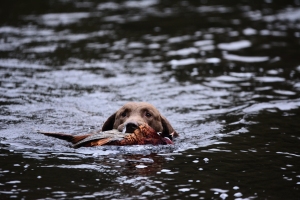
Duck rising off the Tailings at Shelton
We came to the river again for the Duck Drive, just as the late winter sun dipped below the tree line at the top of the valley.
October 2015 will not be remembered for crisp clear mornings bright with frost , it will be remembered instead for record rainfall and temperatures more akin to late summer than early winter. When November 1st arrived at Shelton, although it stayed dry, the unseasonably mild weather had left all gamekeepers with the unwanted headache of trying to keep birds within boundaries when the hedgerows were still laden with natural feeding.
The first frosts hadn’t come, leaving the brambles still green and difficult for both us and the dogs to push through. So by the time we took up our spot on the gravel island at the fork in the river most of the dogs were tired from three heavy pheasant drives and the river was not in a gentle kind of mood.

Full from the heavy rains that fell earlier in the week it would be foolhardy to treat the Avoca, that day, with anything but the utmost respect.
I am always cautious with the dogs I work on the river drive. Young dogs come along only when steady and are kept on lead to watch the older dogs work. I learned my lesson many years ago when I foolishly sent Chester in to this very river on a very lightly wounded duck and watched in horror as the current took both him and the duck round the bend and out of sight. Thankfully, it ended well when he got the duck, found the bank down by the prison and made his way back; but I know it could have ended equally as badly.
Today I had Winnie and Bertie, both experienced dogs in relation to waterwork . We watched as the duck came over the tailings and flew up and across the river. Some were caught by the guns at this stage and from that moment until the end of the drive, thirty minutes later, the dogs were in constant motion.

They worked well with the current , swimming out and turning into it as the birds came downstream to them and then going with the current until it carried them back into their own depth where they brought the birds back to me. They also pushed through the current and retrieved birds that fell on the far bank; occasionally they had an easy run up the gravel island to pick a bird from the stones.
The horn blew, to signal the end of the drive. We had filled two game carriers in that short period of time but there was one final retrieve I needed and as Bertie was the younger and fitter of the pair the task fell to him.
Halfway across the widest and fastest flowing part of the river a piece of deadwood rose from the water, strung with all sorts of debris that had got caught up in its branches now it held a drake mallard captive. The bird had been carried downriver during the drive while the dogs were working on other retrieves so they had no idea it was there and the bits of debris flapping like flags in the current masked any sign of the bird from the island where we stood.

I cast Bertie on a line above the deadwood, aiming him for the far bank, anticipating the current would pull him in line with the branches by the time he reached mid-river. He entered the water and felt that familiar pull of the river as it gripped him determinedly and pulled him downstream; with each powerful stroke, though, he was moving nearer the branches but also being pulled sideways by the current. Every stroke was a battle to simply stay on course. Mid river and the current had carried him to where I expected him to be, Bertie was now below the deadwood . I blew hard on my whistle hoping to get his attention above the roar of the water and asked him to hunt. It worked, he lifted his head clear of the water and searched using both nose and eyes, he caught the scent and locked onto the flapping debris, pumped those shoulders harder than before to drive into the current and slowly, slowly work his way towards those branches. With one final drive he reached his head forward and pulled the duck from where the branches held it tightly, then he let go of all effort and allowed the current to carry him downriver to where it sweeps past the shallow end of the island. There he found his footing, pulled himself clear of the water and with bird in mouth he gave one final shake and made his way back to where Winnie and I waited…

There are plenty of times my dogs and I mess up during the season and I value these as lessons to be learned and move on from. However, every once in a while it all comes together, like this day on the river. These are the days to be treasured for times when I can reach my hand down in search of a brown head and rub a pair of soft brown ears as I retell the story, to any willing ear, of Bertie’s blind duck retrieve on a winters day in Shelton..

Hope you had a great season everyone from Me and the Brown Bunch.xx
.












